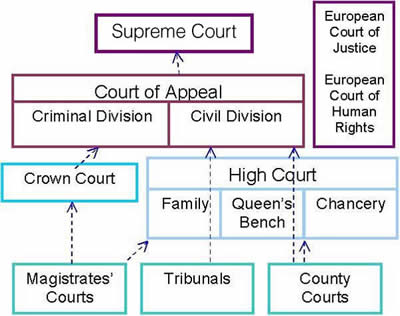Relations Between Institutions
Understanding the Supreme Court
The Supreme Court and its interactions with, and influence over, the legislative and policy-making processes
Role and structure: The Supreme Court was established in the 2005 __Constitutional Reform Act. The aim was to increase the independence of the judiciary from the government- previously, the highest court of appeal in the UK was the Law Lords, who were senior judges also members of the House of Lords. The role of the Lord Chancellor, a government position, was also amended by the Act. Previously, the Lord Chancellor was a cabinet minister (justice secretary), but also the head of the judiciary responsible for appointing judges. This second role was removed from the Lord Chancellor in __2005.
The Supreme Court was opened in 2009, and serves as the final court of appeal in the UK (including all of the regions of the UK). It hears appeals on points of law and matters of legal and constitutional importance. It can make decisions relating to whether government institutions have acted within their powers, including devolved bodies, and can use judicial review to assess whether the government has acted in accordance with existing law. An example of a case heard by the Supreme Court was in 2016-17, when Gina Miller, a businesswoman, argued that the Prime Minister did not have the right to trigger Article 50 (the formal notice of Britain’s exit from the EU) without the consultation of Parliament. The Court found in Miller’s favour, and Parliament voted to trigger Article 50 in 2017.
The Supreme Court sits at the top of the UK court structure, which is as follows:
- Magistrates’- deals with criminal cases mostly
- County- deals with civil cases (e.g. landlord/tenant disputes)
- Crown- deals with more serious criminal cases (judge and jury sentencing)
- High- deals with more complicated civil cases (e.g. adoption, large compensation claims)
- Court of Appeal- hears appeals from civil and criminal cases
- Supreme- hears appeals from Court of Appeal
- European Court of Justice- hears cases involving EU laws which may have been broken
- European Court of Human Rights- deals specifically with human rights issues
The Supreme Court is made up of 12 members. Cases are usually heard by 5-9 judges (depending on the importance of the case) and always an odd number so a majority verdict can be reached. The most senior judge is known as the President (for example, Lord Neuberger), and the majority of judges are white males, which has attracted criticism- in __2017 __there was only one female judge on the court. The first members were the former Law Lords (who were removed from the House of Lords) and will usually have served as a senior judge for 2 years.
Appointments to the Supreme Court are made by an independent selection commission, who recommend a candidate who is then approved or rejected by the Lord Chancellor, who cannot indefinitely reject candidates.
Principles of the Supreme Court
Judicial neutrality: refers to the absence of any form of partisanship or politically biased judgements- a refusal to ‘take sides’ in cases. In reality, it is impossible to be politically ‘neutral’- so judges must not let their own views and beliefs affect their professional behaviour. In the Supreme Court, judges cannot sit in cases involving an associate or family member, and must avoid open political activity.
Criticisms have been made of the extent to which the Supreme Court is politically neutral. Due to their narrow background (white, male, privately-educated) judges have been argued to have a conservative bias, and possibly a bias against women, ethnic minorities and poorer people, as they are less likely to consider their needs and empathise with them. In 2015, Lady Hale (the only female judge) pointed out that since her appointment, 13 judges had been appointed, who were all male, all white, all bar two privately educated, and all bar two Oxbridge-educated. In addition, there has been a rise in judicial activism, especially relating to human rights and civil liberties case, where judges openly criticise the actions of government.
Judicial independence: this is the principle that the actions and decisions of judges should not be influenced by pressure from other branches of government.
This is maintained in a few ways, for example:
- Judges are chosen by an independent commission, and only ‘signed off’ by the Lord Chancellor
- Once appointed, judges can’t be sacked unless they break the law, so they can’t be threatened with removal for making the ‘wrong’ decision
- Judges’ pay is decided by an independent pay review body, without interference from ministers
- The Supreme Court is physically separate from the government and legislature (unlike the previous Law Lords)
Criticisms have been made of the extent to which the Supreme Court is independent of political pressure. Concerns were raised by Lord Phillips in __2011 __about the possible effects of spending cuts on the court system as part of wider ‘austerity’ policies. In addition, the court was heavily criticised by some ministers (backed up by the right-wing press) following the ruling that Article 50 must be triggered by Parliament and not the government, possibly putting pressure on future decisions of the court. However, it remains to be seen whether public criticism of judge’s decisions will have much of an effect.
